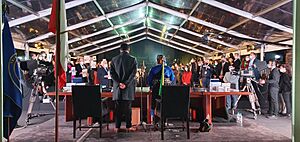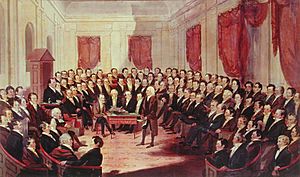Constituent assembly facts for kids
A constituent assembly (also called a constitutional convention or constitutional assembly) is a special group of people brought together to write or change a country's constitution. A constitution is like a rulebook for a country. It explains how the government works and what rights citizens have.
Members of this assembly can be chosen in different ways. They might be elected by people voting, chosen by chance, or appointed. These assemblies are usually different from a regular legislature (which is like a parliament or congress). A constituent assembly has a specific job: to create a constitution. Once they finish, the assembly usually breaks up. This way of making a constitution is a type of representative democracy, where people choose others to represent them.
Unlike when a ruler just makes up a constitution, a constituent assembly creates it from within the country. The people in the assembly are citizens, not necessarily the top political leaders. As a professor named Jon Elster explained, constitutions can be made in many ways, from a single ruler deciding everything to a fully elected assembly writing a new one.
Constituent Assemblies Around the World
Australia
Australia has held four constitutional conventions. These happened in 1891, 1897, 1973, and 1998.
Chile
In May 2021, Chile elected a new constitutional assembly. This assembly had 155 members. It was special because it had an equal number of women and men. Also, 17 seats were saved for people from indigenous peoples (native groups). The assembly had 12 months to write a new constitution. After it was written, people had to vote on it in a special election.
Costa Rica
After the Costa Rican Civil War in 1948, leaders called for an election to choose a Constituent Assembly. This assembly successfully wrote and approved Costa Rica's current constitution.
Denmark
The Danish Constituent Assembly met in 1848. Its job was to create the Constitution of Denmark in 1849. This constitution changed Denmark from a country ruled by a king with total power to a constitutional monarchy, where the king's power is limited by laws. The assembly had 114 elected members, 38 chosen by the king, and government ministers. They met in Copenhagen. On May 25, 1849, the assembly approved the new constitution. King Frederick VII signed it on June 5, 1849. This day is now known as Constitution Day in Denmark.
European Union
The European Convention in 2001 tried to write a Constitution for Europe. However, this constitution was not approved by France and the Netherlands in 2005. It was later replaced by the Treaty of Lisbon in 2007.
France
During the French Revolution (1789-1791), a group of representatives formed the National Constituent Assembly. On June 20, 1789, they met on a tennis court and promised not to leave until they had written a new constitution for France. King Louis XVI later accepted this assembly.
Germany
The Parlamentarischer Rat (Parliamentary Council) in 1948 wrote the Basic Law for West Germany. This "Basic Law" became its constitution. East Germany, which was controlled by the Soviet Union, wrote its own constitution. The Basic Law was finally accepted by all of Germany when the country reunited in 1990.
Iceland
In 2010, Iceland held an election for a constitutional assembly. 25 delegates were chosen. This assembly worked for four months in 2011 and wrote a new constitution. All 25 members approved it. In 2012, the parliament asked the public to vote on the new constitution. 67% of voters supported it. However, the parliament has not yet officially approved the new constitution.
India
The Constituent Assembly of India was chosen to write the Constitution of India. It also served as India's first Parliament after the country became independent. This assembly was formed after talks between Indian leaders and the British government. It first met on December 9, 1946. When India became independent on August 15, 1947, the Constituent Assembly started working as India's Parliament. B. R. Ambedkar helped write the Constitution. The Assembly approved the Constitution on November 26, 1949, which is now celebrated as Constitution Day. It officially started on January 26, 1950, a day known as Republic Day in India.
Indonesia
Indonesia's Constitutional Assembly was created to write a permanent constitution. Its members were elected in 1955. They met for the first time in 1956. However, after four meetings, they could not agree on the main ideas for the state. So, the assembly was dissolved in 1959, and the country went back to its original constitution.
Italy
The Constituent Assembly of Italy was formed in 1946 after Fascist Italy was defeated in World War II. People voted for its members. At the same time, they voted on whether Italy should be a republic or stay a monarchy. Voters chose a republic. The assembly then had to approve the new government and write a new constitution. This constitution was approved on December 22, 1947. The assembly was dissolved in 1948 and replaced by the new Parliament of Italy.
Mexico
Mexico has had several important constituent congresses and assemblies throughout its history to create or change its constitution.
- The first Constituent Congress of independent Mexico met in Chilpancingo during the war for independence. They created the Constitution of Apatzingán in 1814.
- After Mexico gained independence in 1821, another Constituent Congress was formed. This led to the 1824 Constitution.
- Later, in 1854, another Congress was formed. This group created the 1857 Constitution, which was very liberal.
- Finally, during the Mexican Revolution, President Venustiano Carranza formed a Constituent Congress in Querétaro. This Congress wrote the Political Constitution of the United Mexican States of 1917, which is still used today.
Nepal
Nepal has had two Constituent Assemblies. The second one was elected after the first one could not finish writing a constitution. This assembly also acted as the country's parliament. Finally, Nepal created its constitution with a large majority vote. Nepal has since adopted a system called Federalism.
Poland
The Great Sejm (also called the Four-Year Sejm) met between 1788 and 1792. Its main goal was to make the Polish–Lithuanian Commonwealth stronger and reform it. They tried to do this by writing the Constitution of 3 May 1791. This constitution was meant to fix old problems in the country's political system. However, the constitution only lasted for about a year because of a war with Russia and the division of Poland.
Philippines
The Philippines has had several conventions to write or revise its constitution:
- 1898: This convention wrote the Malolos Constitution, which was the basic law for the first republic in Asia.
- 1935: This convention wrote a constitution to create the Commonwealth of the Philippines under the U.S.
- 1971: This convention worked to update the 1935 constitution.
- 1986: After the government changed, a new commission was appointed to write the 1987 Constitution.
Russia
The Russian Constituent Assembly was created in Russia after the October Revolution of 1917. Its purpose was to write a new constitution after the previous government was overthrown.
Sri Lanka
The Sri Lankan Parliament approved the creation of a Sri Lankan Constitutional Assembly on March 9, 2016. This assembly's job is to write a new constitution for Sri Lanka.
Turkey
The Constituent Assembly of Turkey was formed in 1961 after a military takeover in 1960. Its goal was to prepare a democratic constitution. This constitution was prepared and approved by voters in a special election in 1961.
United States
Federal Constitutional Convention
The U.S. Constitutional Convention wrote the United States Constitution in 1787. The people who attended were chosen by their states, not directly elected by the public. Also, not all states sent delegates. The convention was originally supposed to just make changes to the old rules, but they ended up writing a whole new constitution.
The U.S. Constitution does not have a way to be completely replaced. However, Article V allows Congress to call a national constitutional convention to suggest changes. This has never happened.
State Constitutional Conventions
States in the U.S. have a long history of using constituent assemblies. Many states had these assemblies even before the U.S. Constitution was written in 1787. Since 1776, almost 150 state constitutional conventions have met to write or change state constitutions.
Early state conventions often didn't use steps like public voting to approve the constitution. But they were still seen as legitimate because the people had given them the authority. Delegates to these conventions often looked at constitutions from other states for ideas. They would borrow parts of text and rules from other states. They also used small books that had all the existing American constitutions to help them design new ones.
The powers of these state assemblies were often debated. Some thought they had unlimited power, while others believed they had to follow existing laws. In the end, it was generally agreed that elected constituent assemblies had limited powers.
Many U.S. states have held several conventions over the years to change their state constitutions. For example:
- Missouri has held four conventions.
- Michigan has held five conventions.
- Massachusetts has held six conventions.
- New York has had nine Constitutional Conventions.
- Vermont had its first constitution written in 1777 and revised it several times.
- Virginia Conventions have included six major meetings.
Countries Without a Fixed Constitution
Some countries do not have a single, fixed constitution that is hard to change. Instead, their laws can be changed by regular lawmaking. The United Kingdom, New Zealand, and Israel are examples. In these countries, there is no need for constituent assemblies because the regular lawmakers can change the constitution.
Even without a written constitution, the United Kingdom has had some conventions for specific regions:
- The Northern Ireland Constitutional Convention (1975–1976) tried to find a solution for Northern Ireland, but it didn't succeed.
- The Scottish Constitutional Convention (1989) created a plan for devolution (giving more power to Scotland).
New Zealand's constitution is made up of many different laws, treaties, and court decisions. Because it's not one supreme law, it's easier to change. It only needs a majority vote from Members of Parliament.
In Israel, the Knesset (their parliament) acts as the country's ongoing constituent assembly. The Knesset can create "Basic Laws," which are like parts of a future constitution, as well as regular laws.
|
See also
 In Spanish: Asamblea constituyente para niños
In Spanish: Asamblea constituyente para niños
- List of constituent assemblies
- Convention parliament
- Constituent Cortes
- National Constituent Assembly (disambiguation)
- Third Dáil, also called the Constituent Assembly





